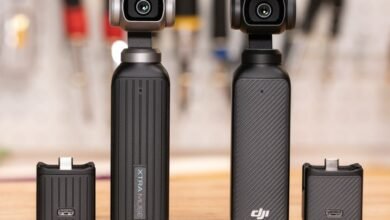Pokémon Legends: Z-A Rotom Phone Upgrades: Better Camera, Higher Jumps

▼ Summary
– The third-generation Rotom Phone in Pokémon Legends: Z-A features improved hardware, including a more functional camera array with zoom and hands-free usability.
– Its standout Roto-Glide functionality allows users to cushion falls and gain a jump boost, ideal for navigating Lumiose City’s rooftops and obstacle courses.
– The device includes an updated Pokédex app with Lumiose-specific data and a Z-A Royale hub, but lacks the fancy monster artwork from previous versions.
– While the phone has excellent battery life and call quality within Lumiose City, it may not work outside the Kalos region and has limited accessories.
– Despite incremental upgrades from the previous model, the new Rotom Phone is essential for maximizing the urban exploration experience in the game.
The latest Pokémon Legends: Z-A introduces a significantly upgraded Rotom Phone, blending enhanced camera capabilities with innovative movement features tailored for navigating the bustling streets and rooftops of Lumiose City. While the design remains understated, the new functionalities make this device an essential companion for any trainer exploring the Kalos region.
Previous Rotom Phone models set the stage for this evolution. The original version from Sword and Shield offered a basic camera for capturing wide shots in the Galar Wild Area. Its successor in Scarlet and Violet improved the camera and introduced a life-saving safe-landing feature to prevent fall damage. Though neither matched the distinct visual style of the Arc Phone from Pokémon Legends: Arceus, they demonstrated a clear trend toward more streamlined and powerful tech. The third-generation Rotom Phone continues this progression, now optimized for an urban environment.
Visually, the new phone maintains a conservative look, a reminder that Pokémon gadgets have become less distinctive since the Pokédex transitioned from a physical object to a simple app. However, its lack of aesthetic flair is more than compensated by superior hardware and new abilities, especially the Roto-Glide feature that simplifies rooftop navigation, making it a must-have for anyone visiting Lumiose City.
One of the most welcome improvements is the camera system. Scarlet and Violet’s dual-lens setup lacked a zoom function, forcing trainers to approach wild Pokémon dangerously close just to take a picture, a risky move in Lumiose, where unpartnered monsters won’t hesitate to attack. The new model adds a third lens with a practical zoom, and crucially, the rear cameras can now be used while moving. This allows you to photograph Pokémon discreetly from a safe distance, and if you’re spotted, you can quickly retreat without fumbling with your device. The front-facing camera still requires you to stand still for use, but it supports video calls and has an improved sensor.
Taking selfies has also been refined. Earlier models required you to hold the phone or use a selfie stick to photograph yourself with your partner Pokémon. Now, the resident Rotom can maneuver the device hands-free, capturing shots from various angles and distances. This is perfect for updating your profile picture if you’re participating in the Z-A Royale. One limitation is that you must remain stationary while directing the Rotom to photograph you. Using the phone’s built-in music, you can influence your Pokémon’s mood, calming them to sleep or exciting them, to set up candid or dramatic shots. The built-in filters are fairly basic, but photos can easily be transferred to another device for more advanced editing.
Beyond the camera, the updated Pokédex app is one of the phone’s most valuable tools. It performs all standard functions, tracking seen and caught Pokémon, mapping species locations, and documenting behavior, and includes a dedicated catalog of Pokémon capable of Mega Evolution. Unlike the previous model, every catchable Pokémon now receives its own unique entry. While the new Pokédex lacks the artistic illustrations seen in Scarlet and Violet, its interface is cleaner, more intuitive, and avoids excessive skeuomorphism. The default map app is also more informative, highlighting which Pokémon inhabit Lumiose’s Wild Zones, marking Z-A Royale battle locations, and providing details on key spots like shopping centers and Pokémon Centers.
The standout feature, however, is Roto-Glide. Building on the last phone’s safe-landing mode, Roto-Glide provides a brief upward boost when jumping from a ledge, letting you bounce through the air. This makes traversing rooftops and completing scaffold-based obstacle courses remarkably smooth. It’s a genuine game-changer for urban exploration.
Battery life and call quality are excellent within Lumiose City, consistent with earlier Rotom and Arc Phone models. It’s unclear whether the device functions outside the Kalos region, as testing beyond the city wasn’t possible. Some users have accessed a wide-screen tablet mode, though activating it wasn’t straightforward. Performance overall is fluid and reliable.
A notable downside is the scarcity of personalization options. The phone comes in several colors, red, blue, yellow, white, and stony gray, but lacks the variety of cases and accessories available in regions like Paldea.
Aside from Roto-Glide, the new Rotom Phone feels like an incremental upgrade for those coming from the previous generation. Still, its enhanced camera and specialized apps are indispensable for fully experiencing Lumiose City. With the potential addition of stylish accessories in the future, this device could easily become the ultimate trainer tool.
(Source: The Verge)



